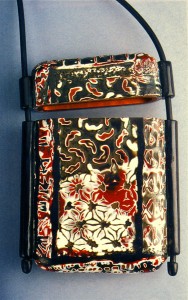Keep on Stackin’: Mokume Gane – Part 3

Just as Tory and Lindly built upon Nan’s original concept of polymer mokume gane, others followed and added their own variations to the process. The approach to “stack and distort” kept evolving.
Celie Fago combined Tory’s and Lindly’s techniques. Celie used slightly tinted translucent polymer layered with metal leaf, which was adapted from Lindly, as well as layers of black and pearl opaque polymer, but then pushed down into the stack from above as in Tory’s approach. Her results achieve a fluid, organic look.

Kathleen Amt, book form with mokume gane employing V-cutouts
By carving into the top, Kathy Amt was able to position and delineate the distortions. Using a linoleum cutter tool with a V shaped form, and/or a traditional ceramic clay trimming tool, Kathy removed lines and bits of polymer from her “stack”. This created grooved gouges in the top of the polymer sheet, which was then rolled through a pasta machine to flatten out the gouges and further expose the different strata of color. Sometimes the layers were so thin as to create an airbrush blended appearance.

Nan Roche, Inro with mokume gane employing stamps and molds
After her initial experiments, Nan varied her approach by pressing deeply cut rubber stamps into the top of the stack/loaf. The irregular surface was either carved or cut away to reveal the underlying layers. Unlike so many of the other mokume gane techniques, which sought a random effect, this approach had the potential to recreate the particular pattern of the stamp. Nan also inverted the concept by pressing a stacked slab of polymer into a well defined mold. The mold design distorts the bottom layers of polymer. Once released and cured, the impressed surface of the polymer form is sanded to expose the multiple layers.

Marie Segal, Brooch with mokume gane employing the ripple blade
A new alternative developed with the use of a wavy or ripple blade. Jami Miller introduced the ripple blade to Marie Segal around 1996. Marie arranged various colors into a chunky loaf. This loaf was cut into perpendicularly across the layers using a ripple blade. Marie used this basic technique to achieve what she called Faux Abalone.

Dan Cormier, Brooch showing mokume gane made in chatoyant polymer
And lastly, there is a group of mokume gane techniques that utilize the chatoyant properties of polymer, which can create dazzling tone on tone effects. While polymer chatoyance was initially explored by Pier Voulkos, Dan Cormier expanded its range by pressing precise shapes into pearlized monochromatic stacks of polymer and then cutting away a very thin, even layer of the surface. The results are shadow like images that read with great dimensionality but in reality are totally flat.